Growth and Development
Part of the joy of writing characters together is that they might find a mate and have a litter. Litters are exciting for everyone involved, the parents, the adopters, and those who interact with the babies. Reproduction on-site is the only way for a player to experience roleplaying a newborn puppy, and all the stages that come after. This guide will help you through the process of puppy growth!
A quick note: Our daily script may age a puppy inappropriately. If puppies are born the last week of Late Spring, they will automatically jump to 1 month even if they should only be 1 or 2 weeks old. Due to this, you should follow the number of weeks since the pup is born up until they reach 8 weeks old. At this point, you can track their age based on the site's seasonal progression.
Wolf images for this page are from Wikimedia Commons, another from Wikimedia Commons, and the others are from Dawnthieves.
A quick note: Our daily script may age a puppy inappropriately. If puppies are born the last week of Late Spring, they will automatically jump to 1 month even if they should only be 1 or 2 weeks old. Due to this, you should follow the number of weeks since the pup is born up until they reach 8 weeks old. At this point, you can track their age based on the site's seasonal progression.
| Wolf Development | |
|---|---|
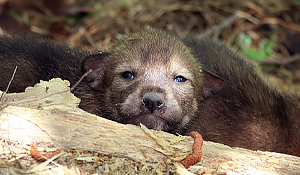
|
Neonatal: Newborn to 2 weeksPuppies at this stage very much resemble potatoes and many in the community may even refer to them as puptatoes. Born blind and deaf, puppies grow quickly in their first two weeks. At birth they are around a pound old and they should put on several ounces a day. By day 10 their eyes and ears begin to open. They are kept safely in the den and away from the rest of the pack. |
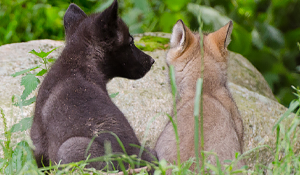
|
3 to 4 WeeksAs they approach a month of age, pups will begin to leave the den to explore and play. At this point, they are often introduced to other members of the pack. They can start eating food that is regurgitated by older wolves, but have a hard time eating anything else. They are playful and explorative, but do not go far from the den. Puppies begin getting their baby teeth at this point and are prone to chewing on any and everything to help the process. |
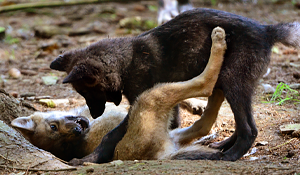
|
2 MonthsThe two month marker is a big step for a pup. Not only do we start tracking their aged based on our seasonal roll-over, but they also get to move den sites! Wolves will move their puppies from their birth den to a rendeszvous site at 2 months old. This is due to their original den ending up being too stuffy, and to avoid parasites such as fleas. Pups at this age are incredibly playful and inquisitive, and begin to mimic adults and learn about their behavior. Puppies are either fully weaned or nearly fully weaned at this stage. |
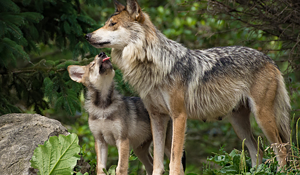
|
3 MonthsAh, yes, the gangly puppy phase. Puppies at 3 months are often in their gangly phase. Over-large paws, big ears, and wide eyes. They still have their needle-like puppy teeth at this point and should be fully weaned and on a semi-solid diet. At this point they still rely on regurgitated food or small morsels offered to them by adults. Due to their puppy teeth, they will struggle to eat prey otherwise. Puppies at 3 months old should energetic and alert, and are about half the size of their adult age. They may take interest in learning about pack social dynamics and roles within the pack. |
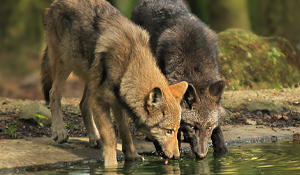
|
4 MonthsAt around four months, puppies begin to look a lot like small adults. The equivalent of a young child, they are explorative and playful. They may take interest in hunting but do not begin to join in on hunts. They may watch, and practice on each other, though. Puppies also might start losing their puppy teeth at this stage, and each puppy is unique on when the process begins. This means the second round of puppy teething stage and they are happy to mouth literally everything. |
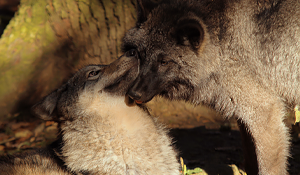
|
5 MonthsIf four months is the equivalent of a small child, then five months is the equivalent of a pre-teen. These puppies are rambunctious and nearly their full height already. They look very much like adults in a smaller body, though they may still have too-large ears or paws. They begin to properly learn skills now such as hunting and medicine, and are eager to practice and play equally. Some pups may take to helping with border patrols and some packs choose this time to appoint apprentices to adult wolves. |
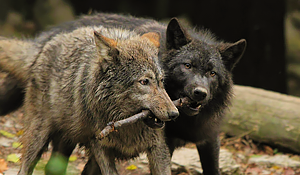
|
6 MonthsHalfway to adult hood means we're entering early teens. The early stages of puberty begin at this point. This can cause some pups to be more moody, rebellious, or independant. They are contributing by hunting small prey and actively working to contribute to the pack in most cases by now. Despite this, they are also still children and will take the time to play or frolic as well. |
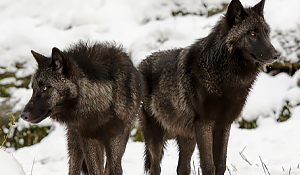
|
7 MonthsThe growth spurt between 6 and 7 months puts puppies at about mid-teens. They are active and alert and can survive on their own in the wild. By now all of their adult teeth should be in, and they should be capable of fighting off predators and other wolves. While they still benefit from the closeness of their pack, some pups at this age will start to branch out a little more as they explore their independance. |
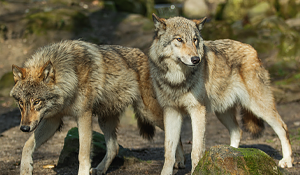
|
8 to 16 MonthsThe final stage of growth is between eight and sixteen months. These puppies are about as mentally mature as a late teen. At this point they are still growing, but it has slowed dramatically, and they can blend nearly seamlessly in with the adults from afar. Hormonal changes as they push into full puberty can make them much more moody, as their body begins to produce hormones properly. They are fully able to communicate now and should be well engrained into the daily life of the pack. |
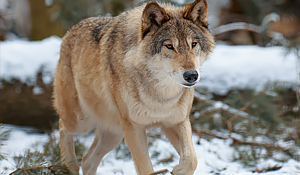
|
1.5 to 3 YearsFinally considered young adults, these babies have matured into wolves. Wolves at this stage may have another gangly phase as they have not yet built their full body mass. Wolves will continue to build body mass and grow slowly until they've reached 3 years old. They are sexually mature at this point, though they are still growing and maturing just like a young adult human would be. Their unique traits may show most clearly now as they begin figuring out who they are and what they stand for. Wolves who picked up on some skills as puppies should be well-rounded by now, though they are still learning and improving. |
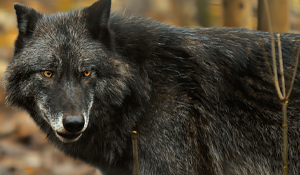
|
4 to 7 YearsAs wolves approach four years of age, they are considered to be proper adults. All wolves will have stopped growing at this point. Wolves with a graying gene may begin to start phasing too. Black wolves in particular begin to phase at this point, gaining gray or white hairs along their muzzles and interspersed throughout their coats. Wolves at this age are fully capable and emotionally mature, and contribute well to society. It should also be noted that wolves at this age should be masters of the skills they've been practicing. |
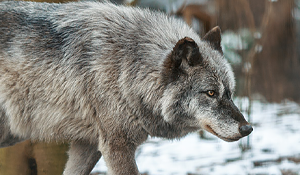
|
8 or More YearsDon't tell them this, but wolves eight years or older are often considered senior. Though they may not begin to slow down until they've reached 10 or older, these wolves are pushing past their prime by this point. They will have changed color drastically from their youth if they have the graying gene mentioned above. In fact, the wolf in the image for four to seven years is the same wolf as here, just a few years apart! Wolves at this age are often begining to slow down and may consider retirement. Though, some are definitely too stubborn for that. |
Wolf images for this page are from Wikimedia Commons, another from Wikimedia Commons, and the others are from Dawnthieves.
Last Edited: June 23, 2025
Editor: Carey
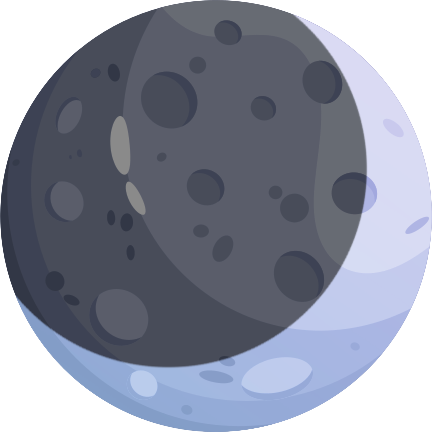 Late Summer Y0 |
Sunny |
95°F / 35°C
Late Summer Y0 |
Sunny |
95°F / 35°C










